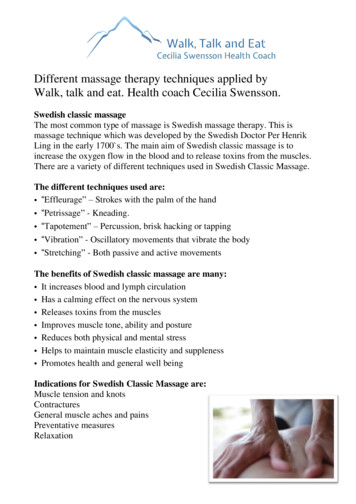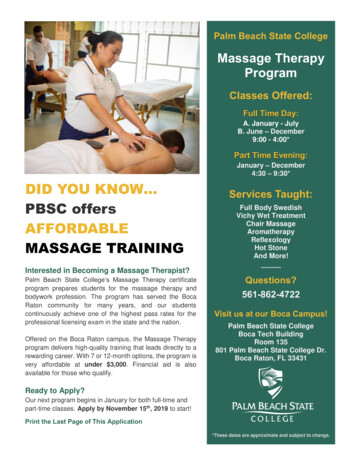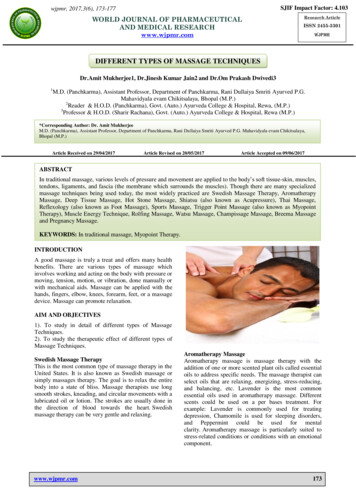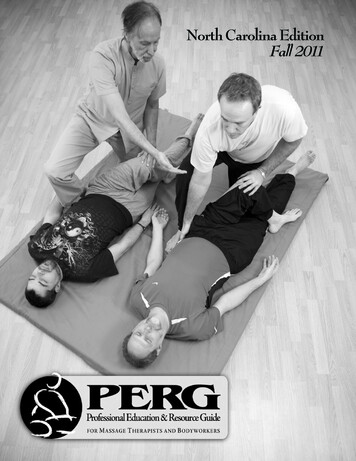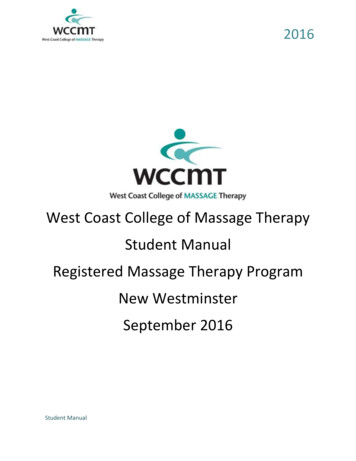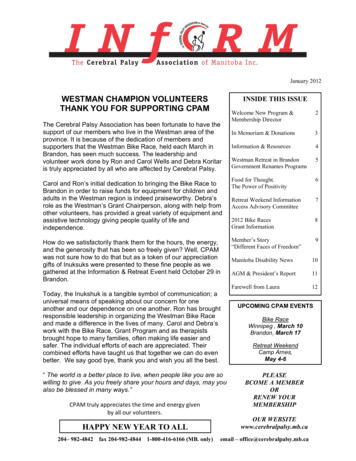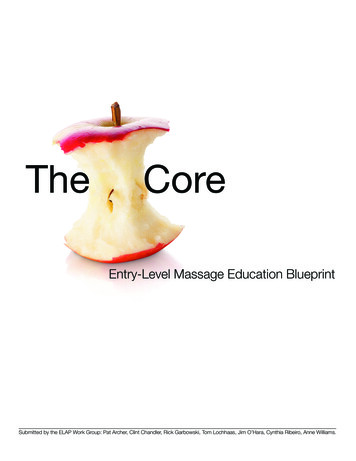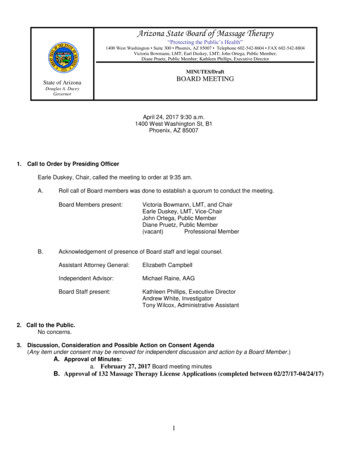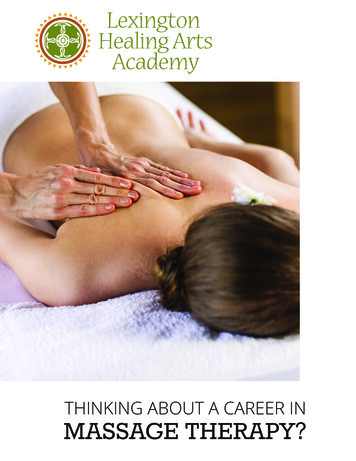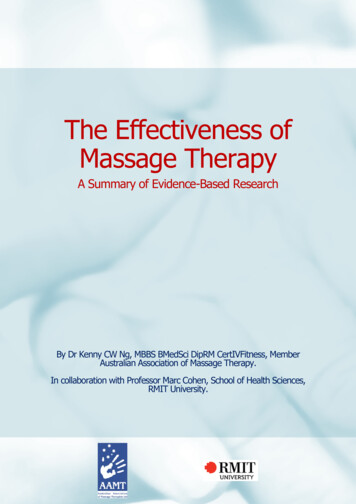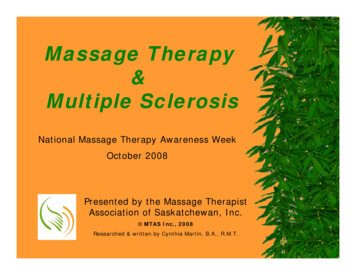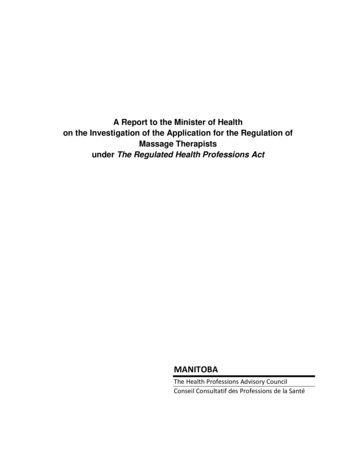
Transcription
A Report to the Minister of Healthon the Investigation of the Application for the Regulation ofMassage Therapistsunder The Regulated Health Professions ActMANITOBAThe Health Professions Advisory CouncilConseil Consultatif des Professions de la Santé
MANITOBAThe Health Professions Advisory CouncilConseil Consultatif des Professions de la Santéc/o 300 Carlton StreetWinnipeg, Manitoba R3B 3M9Fax: (204) 945-1020hpac@gov.mb.caSeptember 18, 2015The Honourable Sharon BladyMinister of HealthRoom 302Legislative BuildingWinnipeg, ManitobaR3C 0V8Dear Minister,The Health Professions Advisory Council (the “Council”) is pleased to submit to you its reportrespecting the regulation of massage therapists in response to your referral of the applicationmade by the Massage Therapy Association of Manitoba (“MTAM”).MTAM is a voluntary professional association whose members agree to abide and be bound byits bylaws, code of ethics and standards of practice. MTAM has been praised by some who saythat voluntary self-regulation has been effective in providing Manitobans with competent andtrained massage therapists and monitoring the industry for unethical practitioners. MTAM’sapplication indicates that it has been pursuing self-regulation since 1974.The Council has investigated the question of whether massage therapists should be regulatedunder The Regulated Health Professions Act through the establishment of a college of massagetherapy.Based on the Council’s consideration of relevant factors and the evidence presented to it, theCouncil notes that while the profession does not perform reserved acts, the Council is satisfiedthat there is a risk of harm to the public from incompetent practice of the profession, albeit nota substantial risk.It is noteworthy that the activities massage therapists perform are within the public domainand so there is no prohibition to prevent others from performing such activities, includingunregulated practitioners. However, the Council recognizes that the regulation of the
profession will reduce the risk of harm to the public to the extent that the practitioners meetthe registration requirements of its regulatory college, submit to become members of itsregulatory college and comply with the terms of membership, thereby permitting them to usethe protected titles recommended by the Council. The public will know a practitioner is part ofa regulated profession because the practitioner will be permitted to use a protected title.If you wish, the Council would be pleased to meet with you to discuss our recommendations.Sincerely,Original signed byNeil Duboff, ChairHealth Professions Advisory CouncilOriginal signed byOriginal signed byDavid SchellenbergLynne FinemanOriginal signed byOriginal signed byBev Ann MurrayJohn Harvie
Table of ContentsExecutive Summary . 1Introduction. 4Proposals for New Professional Regulation . 5Regulation Administered by Government or by the Profession . 6Section AThe Massage Therapy Association of Manitoba Application. 8The Status of Massage Therapy in Manitoba . 8Criteria for Self-Regulation . 11The Council’s Examination of the Application . 12Relevance to the Minister of Health . 131.Risk of Harm . 152.Sufficiency of Supervision . 203.Alternative Regulatory Mechanism . 214.Body of Knowledge . 245.Educational Requirements for Entry to Practice . 276.Leadership’s Understanding of Need to Favour the Public Interest . 317.Membership support . 338.Economic Impact of Regulation. 369.Public Need for Regulation . 38Summary . 39Section BScope of Practice, Reserved Acts and Titles . 40Summary of Recommendations . 47Appendix A – List of Participants** . 49
1Executive SummaryIn a July 10, 2012 letter, the Minister of Health (the “Minister”) indicated that theMassage Therapy Association of Manitoba (“MTAM”) had applied for designation as aregulated health profession under The Regulated Health Professions Act (the “RHPA”).The Minister asked the Health Professions Advisory Council (the “Council”) toinvestigate and advise whether massage therapists should be regulated in Manitobaunder the RHPA and, “if so, what would be the appropriate college, scope of practice,reserved acts and titles”.As part of its investigation, the Council gave public notice of its review of MTAM’sapplication and invited interested parties to participate. Twenty-five individuals andorganizations participated in the review (the “Participants”) of MTAM’s application.The Council’s Mandate and Terms of Reference require that its advice to the Ministerbe based on evidence, academic or professional studies, the opinion of experts andother interested and informed persons. This requirement is meant to guard against theadvice of the Council being based on anecdotes, subjective preconceptions or instinct.The Council understands that its duties under the RHPA are carried out in order toprovide advice to the Minister about matters related to the RHPA, including whether toregulate a profession under the RHPA. Section 161(1) RHPA requires thatDRAFTUpon completing an investigation, the advisory council must recommend to theMinister, with reasons (emphasis added), whether or not it would be in the publicinterest that the health profession be regulated under this Act.In order to provide a transparent process to review requests for designation as aregulated profession, applicants must provide responses to a series of questions basedon criteria identified in Section 159 of the RHPA1: 1Whether a substantial portion of the profession’s members are engaged inactivities that are under the jurisdiction of the Minister.The nature and degree of risk of physical, emotional or mental harm toindividual patient/clients arises from incompetent, unethical or impairedpractice of the profession having regard to:o the services performed by the practitioners;In accordance with the RHPA, the Council “must have regard to all matters that it considers relevant, which mayinclude those” identified in s 159.
2 o the technology, including instruments and materials, used bypractitioners; ando the invasiveness of the procedure or mode of treatment used bythe practitioners.Whether a significant number of the members of the profession do nothave the quality of their performance monitored effectively.Regulation under the RHPA must be a more appropriate means toregulate the profession than other means.Whether the health profession is a distinct and identifiable profession witha distinct and identifiable body of knowledge that forms the basis of thestandards of practice of the profession.There must be qualifications and minimum standards of competence forpersons applying to practise the profession.The profession’s leadership has shown that it will distinguish between theinterests of the public and the profession’s self-interest and, in selfregulating, will favour the former over the latter.Sufficiency of membership support and willingness to be regulated.The potential economic impact of regulation on the profession, the publicand the health care system.The applicant’s responses to the questions allows for the analysis of whether the healthprofession should be regulated under the Act and, if so, for analysis regarding theappropriate college to regulate the practitioners, scope of practice, reserved acts andtitles.DRAFTCurrently, massage therapy in Manitoba is not a regulated profession. At the time ofthis writing, the Council is aware that the only required licensing for massage therapistsare for those massage therapists practising in the cities of Thompson and Winnipegwhere the practitioners are required to obtain a business licence under municipal bylaws. Anyone, with or without qualifications, can call themselves a massage therapistand/or practise massage therapy. Other than for those massage therapists whovoluntarily belong to MTAM, there is no requirement for massage therapists to adhere tostandards for education and qualification, participate in a continuing competencyprogram, comply with practice standards and a code of ethics, or subject themselves toa complaints and discipline process.Massage therapists do not perform any reserved acts nor did MTAM request that itsmembers have the authority to perform any; all the activities of massage therapists arewithin the public domain. Therefore, there is no prohibition to prevent unregulatedpractitioners from performing these activities. The public will only be protected by the
3provisions of the RHPA to the extent that a massage therapist meets the entry-topractice requirements of a Manitoba college of massage therapists and allowsthemselves to be regulated by the college. Massage therapists who do not meet theentry to practice requirements of a college of massage therapy or choose not to be amember may practise massage therapy but would not be permitted to use any of theprotected titles.The Council finds that there is a risk of harm involved in the provision of massagetherapy services, albeit not a substantial risk. The Council is of the opinion that thisharm will be mitigated through a college of massage therapy which would setqualification standards for entry to practice, standards for practice and which wouldallow the public to access a complaints and discipline process. Reserving the use ofthe recommended protected titles for members of the college will let the public knowthat they are accessing massage therapy services provided by qualified members of theprofession.Based on the Council’s investigation:1. The Council recommends that the profession of massage therapy proceed toregulation under the RHPA to be governed by a College of Massage Therapy ofManitoba.2. The Council recommends that the scope of practice statement for the professionof massage therapy be as follows:DRAFTThe practice of massage therapy is the assessment of the soft tissues andjoints of the body, and the treatment and prevention of physicaldysfunction and pain of the soft tissues and joints by manipulation todevelop, maintain, rehabilitate or augment physical function, to relievepain, or to promote health.3. The Council recommends that massage therapists not be granted authority toperform reserved acts under The Regulated Health Professions Act.4. The Council recommends that the following titles and its variations, abbreviationsand initials be restricted to members of the College of Massage Therapy ofManitoba: “massage therapist”; “registered massage therapist”; and “licensed massage therapist”.
4IntroductionThe Manitoba Law Reform Commission 1993 discussion paper, The Future ofOccupational Regulation in Manitoba noted that “in Manitoba, there is at present nosingle structure within the Legislature, the Cabinet or the provincial bureaucracydesigned to consider proposals . . . for the introduction of a regulatory regime. . . . As aresult, it is not clear why some applicant groups are granted self-government whileothers are not.”2 Subsequently, the Manitoba Law Reform Commission Report #84,Regulating Professions and Occupations recommended that the purpose ofoccupational regulation should be to protect the public from harm; it should not be usedto benefit or reward practitioners.3 In 2006, Manitoba Health (the “Department”) decidedto replace the fragmented arrangements for the regulation of health professionals andreplace it with a common legislative framework that would address the findings of theLaw Reform Commission. In January 2009, the Department released a consultationdocument which proposed umbrella legislation to consolidate Manitoba’s many healthprofession statutes under a common legislative framework.4 The Regulated HealthProfessions Act (“the RHPA” or “the Act”) was passed by the Legislature in June 2009for this purpose.The relevant provisions of the RHPA which established the Health Professions AdvisoryCouncil (the “Council”) were proclaimed effective June 1, 2011, in advance of theenactment of the provisions of the balance of the Act. With the exception of a number ofprovisions relating to specific professions, the remainder of the RHPA was proclaimedinto force on January 1, 2014. Audiologists and speech-language pathologists are thefirst two regulated health professions to transition to regulation under the RHPA.Professional self-regulation continues for the remaining health professions governed by21 separate acts which are intended to be phased out as the corresponding healthprofession is brought under the provisions of the RHPA.DRAFTThe purpose of the Council is to provide advice to the Minister on matters related to theregulation of health professions in Manitoba. On the Minister’s request, the Council isto provide advice about any matter related to the Act, including advice about: Whether an unregulated health profession should be regulated under the Act;2Manitoba Law Reform Commission (November 1993) The Future of Occupational Regulation in Manitoba at 6.3Manitoba Law Reform Commission (October 1994) Regulating Professions and Occupations at 23.4Manitoba Health. Proposed Umbrella Health Professions Legislation: The Regulated Health Professions Act.January 2009.
5 Whether the list of reserved acts should be revised;Who may or may not perform reserved acts;The use of professional or occupational titles by members of a regulatedhealth profession or other persons;Entry-to-practice requirements for health professions;The continuing competency programs established by colleges; andHealth human resource planning and management.To assist the Council in formulating its advice to the Minister, Section 150 of the RHPAallows the Council to consult with or engage experts, persons who have informationrelevant to the work of the Council, and persons who have technical or specializedknowledge related to the work of the Council; to receive submissions; and to hold publicmeetings. These powers afforded the Council are meant to guard against its advicebeing based on anecdotes, subjective preconceptions or instinct. The Councilunderstands that its duties under the RHPA are carried out in order to provide advice tothe Minister about matters related to the RHPA, including whether to regulate aprofession under the RHPA.Proposals for New Professional RegulationOne of the key provisions of the RHPA is the formalization of the process to addressproposals for new professional regulation. The over-arching principles for regulation ofa group under the RHPA are:DRAFT(1) the profession delivers health care as defined by the RHPA,(2) the health care provided by the practitioners poses a risk of harm to the public;and(3) regulation under the RHPA is the most appropriate means to regulate theprofession.The legislation sets out the general process for an unregulated health profession toapply to be regulated. A group seeking to be regulated as a health care professionapplies to the Minister of Health (the “Minister”) in the form and containing theinformation required by the Minister. Applicants must complete a questionnaire asprescribed in an appendix to the Application Process for Requests for Self-Regulationunder the RHPA. Producing evidence, applicants must establish, among other things,that; the profession is identifiable;there is general agreement on qualifications, standards and competencies;
6 the profession’s leadership will favour the public interest over the profession’sself-interest;the members of the profession support regulation and will be compliant; andthe profession has an understanding and appreciation of the economic impact ofregulation on its members, the public and the health care system.Section 161(1) RHPA provides thatUpon completing an investigation, the advisory council must recommend to theMinister, with reasons (emphasis added), whether or not it would be in the publicinterest that the health profession be regulated under this Act.Regulation Administered by Government or by the ProfessionThe primary purpose for a government to regulate an activity is the protection of thepublic from harm. Generally, professional regulation is generated and administered bygovernment. In some cases, government delegates to a profession or occupation theprivilege of self-regulation. In its 1994 report, the Law Reform Commission explainedthe difference between government administration of regulation and self-regulation:In general, when government decides to introduce regulations to control aparticular activity, it administers them itself.Frequently, a governmentdepartment is assigned this task, in which case departmental employeesadminister the regulations directly. Government can also administer a regulatoryregime indirectly by using a body it appoints but which acts at arm’s length fromgovernment. . . .DRAFTSelf-governing occupational groups . . . are an exception to the general rule ofadministration of regulation by government.The classic model of selfgovernment represents a delegation by the Legislature of administrative authorityto an organization whose officers and directors are elected by practitioners ratherthan being appointed by government. . . . Just as government is expected toexercise its administrative powers in the interest of the public, so administrativepowers wielded by practitioners should be exercised only in the public interest.5The delegation of authority by government to self-governing organizations, or “colleges”,gives colleges the authority to register applicants who meet the qualifications for entry topractice established by the college, establish and monitor the standards of practice for5Manitoba Law Reform Commission (October 1994) Regulating Professions and Occupations at 46.
7the profession, and administer a complaints and discipline process. The objective ofregulation is to protect the public interest and ensure the public that the profession’spractitioners are qualified, competent and will conform to the appropriate standards ofcare and conduct.DRAFT
8Section AThe Massage Therapy Association of Manitoba ApplicationIn July 2012, the Minister of Health, the Honourable Theresa Oswald, referred to theCouncil an application by the Massage Therapy Association of Manitoba (“MTAM”) forthe designation of massage therapy as a regulated health profession under the RHPA.The Minister instructed the Council “to investigate and advise whether massagetherapists in Manitoba should be regulated under the Act and if so, what would be theappropriate college, scope of practice, reserved acts and titles”.The Council’s activities with respect to MTAM’s application included:1. A public notice of the Council review of the MTAM application.2. The distribution of MTAM’s application to individuals and organizations whoindicated a willingness to participate in the review.Participants in theconsultation process are listed in Appendix A (the “Participants”).3. The receipt of written submissions from Participants.4. The exchange of submissions from Participants and the opportunity for MTAMand the Participants to provide written responses to any of the submissions fromother Participants.5. Correspondence from the Council to MTAM requesting written responses to a setof questions in relation to its application.6. The distribution to Participants of MTAM’s responses to the Council’s questionsand an invitation for Participants to comment.DRAFTThe Status of Massage Therapy in ManitobaCurrently, massage therapy in Manitoba is not a regulated profession. At the time ofthis writing, the Council is aware that the only required licensing for massage therapistsis for those massage therapists practising in the cities of Thompson and Winnipegwhere the practitioners are required to obtain a business licence pursuant to municipalby-laws.The City of Thompson Business Licensing By-law No. 1677-2002 defines a “massagetherapist” as “a person who is an operator or an employee of a massage therapy clinicand who is a registered member of a recognized Canadian Massage TherapyAssociation” and defines a “massagist” as “any person carrying on the business oroccupation of massaging, whether as operator of a massage clinic or as an employee orassistant therein or otherwise, but does not include a registered physiotherapist or amassage therapist.”
9Under the City of Winnipeg Doing Business in Winnipeg Bylaw No. 91/2008, a “body rubpractitioner” does not include any health professional regulated under the RHPA, amassage therapist, an esthetician or a member in good standing of an exemptorganization. The Bylaw further defines a “massage therapist” as a member in goodstanding with MTAM, the College of Massage Therapists of British Columbia, theCollege of Massage Therapists of Ontario or the College of Massage Therapists ofNewfoundland and Labrador or a person who provides evidence that they havegraduated from an educational program in massage therapy which requires a minimum2200 hours of study or completion of a 2-year program. The Bylaw defines an “exemptorganization” as one that has been registered as a corporation in Canada for at least 5years; members of the organization are governed by a comprehensive code of ethicswhich prohibits sexual relations with clients; membership is restricted to individuals whohave graduated from credible educational institutions; continued membership requirescontinuing competency; members are covered by professional liability insurance; andthe organization has a complaints process. An exempt organization must annuallysupply a list of its members to the City and must immediately notify the City when amember of the organization is suspended, expelled or has their practice restricted.In its application, MTAM indicated that in 2011 it had 746 members of whom 700 werein practice. MTAM operates in Manitoba as a professional and voluntary self-regulatingorganization for massage therapists who wish to join and agree to the following terms ofmembership:DRAFTThe undersigned applicant for Practicing Membership hereby agrees to abideand be bound by the Massage Therapy Association of Manitoba Inc.’s (MTAM)Bylaws, Code of Ethics, Conflict of Interest Code, Policies, Standards of Practice,together with all amendments thereto from time to time, and all additional bylaws,codes, guidelines, policies, practices, procedures and standards that may beimplemented by the MTAM from time to time. The undersigned applicant alsoagrees to disclose to the MTAM the details of any prior or new criminal convictionin Canada or elsewhere, and any new or outstanding criminal charges. . . .Furthermore, the undersigned applicant agrees to conduct their practice withinthe scope of practice of massage therapy, in a competent, professional andethical manner, and in accordance with all of the foregoing.66Massage Therapy Association of Manitoba. Retrieved ticing%20Member%20Application%202014.pdf 27 June 2014
10To gain membership in MTAM, applicants must have completed a two-year massagetherapy diploma program from a recognized school of massage therapy (MTAMrecognizes all schools that are recognized/accredited by the College of MassageTherapists of British Columbia, the College of Massage Therapists of Newfoundlandand Labrador and the College of Massage Therapists of Ontario. MTAM supports aminimum entry-to-practice education of 2200 hours of instruction, or approximately twoyears of academic and practical/clinical education.), and have attained a minimumgrade point average of 75%.7The Natural Health Practitioners of Canada Association (“NHPCA”), based in Edmontonand established in 1988, indicates it represents 365 massage therapists in Manitoba.The NHPCA points out that its members who are massage therapists possess varyingdegrees of education, ranging from 250 hours of study to over 3000 hours of study, andprovide all types of massage therapy, from basic to advanced remedial services. 8Massage therapists are a self-regulated profession in British Columbia, New Brunswick,Newfoundland and Labrador, and Ontario.Table 1: Legislation Regulating Massage Therapists, by ProvinceProvinceAlbertaBritish ColumbiaManitobaLegislationAdministration ofgoverninglegislationMassage TherapyMassage Therapists College of MassageRegulation pursuant Therapists of Britishto the HealthColumbiaProfessions ActDRAFTSelf-regulation(Yes/No)No9Yes7Massage Therapy Association of Manitoba. Retrieved from http://www.mtam.mb.ca/join-mtam.asp8January 3, 2013 letter from NHPCA to Council.9NoAs MTAM notes, massage therapists in Alberta have been transitioning to self-regulation under the HealthProfessions Act since 2009. At that time, the Alberta Minister of Health directed that the Massage TherapistAssociation of Alberta, the Remedial Massage Therapist Association and the Natural Health Practitioners of CanadaAssociation participate on a transitional steering Committee to develop regulation policies and bylaws. In an April4, 2014 letter to the Council, the Natural Health Practitioners of Canada wrote that “discussions continue regardingthe need to regulate and the government is considering surveying practitioners in the province to determine theirview of these issues.” At the time of this writing, there has been no official confirmation that a survey was or hasbeen conducted. The new government elected in Alberta in May 2015 has not indicated whether the regulation ofmassage therapists will be a priority.
11New BrunswickNewfoundland andLabradorNova ScotiaAn Act toIncorporate theCollege of MassageTherapists of NewBrunswickMassage TherapyAct, 2005College of MassageTherapists of NewBrunswickYesCollege of MassageTherapists ofNewfoundland andLabradorNot yet established.YesYes-College of MassageTherapists ofOntario---NoNo10Massage TherapyAct received RoyalAssent May 22,2003Massage TherapyAct, 1991OntarioPrince EdwardIslandQuebecSaskatchewanNoNoDRAFTCriteria for Self-RegulationIn order to provide a transparent process to review requests for designation as aregulated profession, applicants must provide responses to a series of questions basedon criteria identified in section 159 of the RHPA11: Whether a substantial portion of the profession’s members are engaged inactivities that are under the jurisdiction of the Minister.The nature and degree of risk of physical, emotional or mental harm toindividual patient/clients arises from incompetent, unethical or impairedpractice of the profession having regard to:o the services12 performed by the practitioners;10The Massage Therapist Association of Saskatchewan has submitted to the Minister of Health a legislativeproposal for self-regulation and is awaiting a government decision as to whether a bill will be introduced in the Fall2015 sitting of the Legislature.11In accordance with the RHPA, the Council “must have regard to all matters that it considers relevant, which mayinclude those” identified in s 159.12The Council notes that subsection 159(c)(i) refers to “health care” not “services”.
12 o the technology, including instruments and materials, used bypractitioners; ando the invasiveness of the procedure or mode of treatment used bythe practitioners.A significant number of the members of the profession do not have thequality of their performance monitored effectively.Regulation under the RHPA must be a more appropriate means toregulate the profession than other means.Whether the health profession is a distinct and identifiable profession witha distinct and identifiable body of knowledge that forms the basis of thestandards of practice of the profession.There must be qualifications and minimum standards of competence forpersons applying to practise the profession.The profession’s leadership has shown that it will distinguish between thepublic interest and the profession’s self-interest and in self-regulating willfavour the former over the latter.Sufficiency of membership support and willingness to be regulated.The potential economic impact of regulation on the profession, the publicand the health care system.The applicant’s responses to the questions allows for the analysis of whether massagetherapists in Manitoba should be regulated under the Act and, if so, for analysisregardi
Currently, massage therapy in Manitoba is not a regulated profession. At the time of this writing, the Council is aware that the only required licensing for massage therapists are for those massage therapists practising in the cities of Thompson and Winnipeg where the practitioners are required to obtain a business licence under municipal by-laws.
